
Products
Environmental protection equipment bag filter – Longfa
Environmental Protection Equipment Bag Filter - Longfa
After the filter material is used for a period of time, a layer of dust accumulates on the surface of the filter bag due to effects such as screening, collision, retention, bag filter diffusion, and static electricity. This layer of dust is called the first layer. During the subsequent movement, The first layer becomes the main filter layer of the filter material. Depending on the effect of the first layer, the filter material with larger mesh can also obtain higher filtration efficiency. With the accumulation of dust on the surface of the filter material, the efficiency and resistance of the dust collector will increase accordingly. When the pressure difference on both sides of the filter material is very large, some fine dust particles that have attached to the filter material will be squeezed away. Decrease the efficiency of the dust collector. Besides, the high resistance power will dramatically lower air volume of the dust collecting system. Therefore, after the filter resistance reaching a certain volume, the dust should be cleaned in time.

Advantages
The dust removal efficiency is high, generally above 99%, and it has a high classification efficiency for fine dust with submicron particle size.
Simple structure, easy maintenance and operation.
Under the premise of ensuring the same high dust removal efficiency, the cost is lower than that of the electrostatic precipitator.
When using glass fiber, polytetrafluoroethylene, P84 and other high temperature resistant filter materials, it can operate under high temperature conditions above 200C.
It is not sensitive to the characteristics of dust and is not affected by dust and electrical resistance.





















